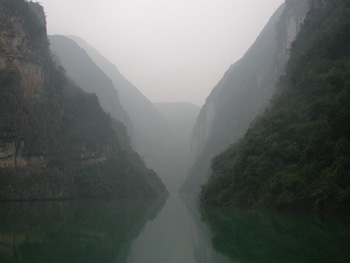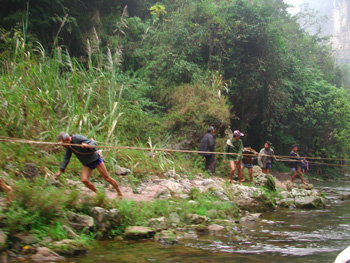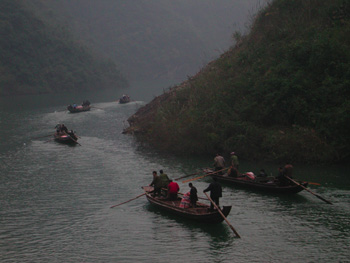Morning Calm, April 1996
Walking On the Wild Side
The Yangtze River, China’s main artery, has been the backdrop to much of the country’s important history and has influenced politics, life and culture.
By PAUL MOONEY in Beijing
 The Statistics Are Staggering. The Yangtze—called the Changjiang, or Long River, by the Chinese—stretches 3,435 miles through nine provinces, making it the third largest river in the world, after the Nile and the Amazon.
The Statistics Are Staggering. The Yangtze—called the Changjiang, or Long River, by the Chinese—stretches 3,435 miles through nine provinces, making it the third largest river in the world, after the Nile and the Amazon.
It has more than 700 tributaries, a watershed area covering 20 percent of China’s total land area, and the river-canal network based on the river handles 80 percent of the country’s internal water transport. The Yangtze River Basin produces some 40 percent of the nation’s grain, one-third of the country’s cotton, 48 percent of its freshwater fish, and 40 percent of total industrial output value.
Some 350 million people—considerably more than the population of the United States – live in the region in which the river and its tributaries travel, their lives all somewhat affected by the river.
“”If one wishes to understand China, one must have some familiarity with the history of the Three Kingdoms and with the lore that surrounds it,” writes Van Slyke in his excellent Yangtze, Nature, History And The River. “Above all, this is true on the middle and upper Yangtze where it seems every bend in the river leads to another site associated with this epoch, and to stories that have grown around it like the layers of a pearl around its grain of historical fact.”
Control of the river has been a military objective many times, and in many instances controlling the middle Yangtze has been the key to the lower river. Without the resources of the lower river, no northern regime could consolidate itself or survive for long.
Control of the Yangtze was an issue in the Taiping Rebellion (1850-1864), when it enabled the rebels to maintain their occupation of Nanjing from 1853-1864. One of the Taiping armies was destroyed on the shores of the River of Golden Sand. The destruction in the region brought about the rebellion and its suppression was enormous.
Nanjing was the capital of Chiang Kai-shek’s Nationalist government in 1928, and the center of his power was always in the middle and especially the lower Yangtze River Valley. The Japanese invasion, however, pushed him farther and farther upriver, first to Hankou, and then past Red Cliff, the Three Gorges and White King City to his wartime capital of Chongqing. Once again, as with Liu Bei of the Three Kingdoms, and like so many other times in Chinese history, Sichuan provided a haven for a regime driven from the crucial arenas of northern and eastern China.
Before the arrival of railroads and highways, bulk transportation usually meant transportation by water. As the country’s main waterway, the Yangtze was known as “China’s Main Street.”
George Raleigh Worcester was employed for 30 years on the Yangtze River by the Chinese Maritime Customs Service as a river inspector. His magnum opus on the junks and sampans that plied the river in the first half of this century provides information on close to 250 different types of craft. Worcester lamented that by his time some of the finest craft had already disappeared, and he considered his work incomplete. The traditional boats plying the Yangtze were sanbans (three-plankers), wubans (five plankers) and junks. Their sails reached high to grab any available wind, and were stiffened by bamboo battens. The sculling oar was quite long, with four men usually needed to work it. Mats overhead protected the passengers from the hazards of the weather, and the decks were covered with coiled ropes.
One of the most interesting craft was the disposable junk from Sichuan. It was developed along the then heavily forested tributaries flowing south toward Chongqing, hastily and crudely assembled from inexpensive lumber. After making a single trip down the river, it was sold for housebuilding, eliminating the need for the arduous trip back against fast rapids and strong currents.
Some large junks were fitted as theaters, sailing between towns and giving performances of Chinese operas to juggling. Others were built as hotels, providing accommodation to travelers arriving too late at night to pass through the city gates. Others served a floating restaurants or teahouses for local residents.
Local pilots were usually hired to negotiate the most difficult rapids, as an error in judgment in negotiating the narrow fairway between submerged rocks could spell disaster. In certain areas trackers had to tow the boats through rough waters.
 Instructions were shouted to the trackers pulling the long hauling ropes over their shoulders—usually way ahead of the boat –by means of a drum beaten at different rhythms. Large freight junks needed as many as 400 trackers, as well as strong swimmers who would loosen the ropes should they snag on rocks along the way.
Instructions were shouted to the trackers pulling the long hauling ropes over their shoulders—usually way ahead of the boat –by means of a drum beaten at different rhythms. Large freight junks needed as many as 400 trackers, as well as strong swimmers who would loosen the ropes should they snag on rocks along the way.
The sad plight of the tracker touched a spot in many of the foreigners who traveled the Yangtze in those exciting days, providing moving accounts of their battle against nature.
Archibald Little, an English trader who pioneered the Wuhan Yichang stretch of the river with his small steamer, the Y-Ling, described in his book Through The Yong Too Gorge, the cry of the trackers, which he said would always be associated in his mind with the upper reaches of the Yangtze River.
“The trackers mark time with their cry, swinging their arms to and fro at each short step, their bodies bent forward, so that their fingers almost touch the ground…Eighty or a hundred men make a tremendous noise at this work, almost drowning out the sound of the rapids, and so often a half a dozen junks’ crews are towing like this, one behind the other. From the solemn stillness of the gorge to the lively commotion of a rapid, the contrast is most startling.”
American author John Hersey, who was born in China, aptly describes this struggle against nature in his novel. A Single Pebble.
“I turned to watch the trackers, for theirs was now the heavy work of making many tons of cypress go uphill on a fiercely resisting roadway of water. It was a moving sight – horribly depressing to see more than 300 human beings reduced to the level of work animals, blind-folded asses and oxen; yet thrilling too, to see the inestimable force of their cooperation for the 350 cloth shoes of their each step up the slope were planted in the same moment, and the sad trackers’ cries ‘Ayah!’ were sung in a great unison of agony and joy and the junks did move.”
Chinese reported that one junk out of 10 would be seriously damaged sailing through the Three Gorges area, and one in 20 would be totally destroyed, with just about 20 percent arriving in Chongqing unscathed. Not one came through without experiencing some close scrapes.
Traveling on the river was a high risk deal. Opium was commonly smoked by the crews, especially after mooring for the night following a harrowing passage through dangerous rapids. More than one traveler observed the master of the ship retreating to his cabin for a tug at his pipe, unable to bear the anxiety of watching his boat—his only means of livelihood—in such dire straits.
In 1854, a wealthy merchant living close to Xingtan, one of the most treacherous of all the rapids in the Three Gorges, raised funds to build three lifeboats to help save passengers and crew. The boats, painted in red to make them stand out form other boats, numbered close to 50 by the early 1900s.
Usually, a red boat accompanied each boat on the treacherous parts of the trip. Whenever an accident occurred, a gun was fired, urging all the red boats to race to the scene. According to one person’s account in 1904, 400 cash was paid for the rescue of a live person from the water, and 800 cash for a dead man, allowing 400 cash for burial after the body was pulled from the Yangtze.
However, if the rescuer managed to keep his clothes dry during the rescue, his reward was just 200 cash.
The hazards of travel resulted in a plethora of rites and taboos that had to be strictly followed to avoid any mishaps during the voyage. The well-known writer Shen Congwen wrote that every boat carried a copy of the Imperial Almanac, sold by itinerant peddlers, which was a “treasured guide to action.”
At the start of a journey, and especially before entering the treacherous Three Gorges, the cook was required to light incense, set off firecrackers, and kill a rooster, sprinkling the blood on the junks bow.
In the late 1800s, junks hired a shaman who would wave a yellow flag inscribed with the Chinese characters “Power of the Water,” while the craft negotiated the waves, to appease the powers of the water. Rice would also be sprinkled on the water all the way through the rapids. Passengers provided the crew with wine, incense and fireworks to guarantee a propitious journey. When the trip was over, they often bought pork as a feast for the crew.
The crews also had to deal with the ghosts of those who drowned on the river. The ghosts were believed to string themselves on a line behind the boat, waiting for an opportunity to board the vessel. The problem was easily dealt with by quickly cutting across in front of another boat, causing the ghosts to be cut loose, and entangled with the unfortunate boat to the rear.
People living along the river had their own superstitions. Pagodas were built beside the river to prevent flooding. It was believed that floods were the work of dragons – since they had the power to control water—or of evil demons. A pagoda built on top of a hill where one of their creatures resided could prevent him from leaving home to cause trouble. And it had the added advantage of preventing the wealth of the nearby town from being carried away by the current.
In the heyday of the Yangtze in the 1920s and 1930s, luxurious steamers made their way all the way from Shanghai up the river to Chongqing. The trip was not completely safe, however, with passengers having to switch to smaller boats in Wuhan for the remainder of the journey.
 About half of the 9,000 navigable miles of the entire river system remains accessible only to native craft – junks, sampans and rafts – beyond the reach of powered boats. However, the traditional forms of river transport slowly grew obsolete, and were eventually relegated to the tributaries of the Yangtze for the transport of goods to the main distribution centers. Although the number of junks has markedly fallen in recent times, travelers on the river can still see a large number and variety of local sailing vessels.
About half of the 9,000 navigable miles of the entire river system remains accessible only to native craft – junks, sampans and rafts – beyond the reach of powered boats. However, the traditional forms of river transport slowly grew obsolete, and were eventually relegated to the tributaries of the Yangtze for the transport of goods to the main distribution centers. Although the number of junks has markedly fallen in recent times, travelers on the river can still see a large number and variety of local sailing vessels.
The Yangtze River system has been crucial to the economic development of China, not just its economic life, but also its social and political life. Without the Grand Canal – the man-made extension to the Yangtze – to carry tribute grain form central China to the capital in the north, historians say Beijing could not have survived as China’s caipital for 700 years.
A Chinese ship captain told Paul Theroux that the mood of the Yangtze changed according to the season, and that it changed every day. “Navigating the river is always a struggle against nature,” the captain said. “And there is only one way to pilot a ship well. It is necessary to see the river as an enemy.”
The Yangtze River had powerful associations for the late Chairman Mao Zedong. Mao was raised on the stories of the heroic battles of the Three Kingdoms period which took place on the river, and he often sailed it in his luxury boat, the Kunlun.
Mao always loved swimming, seeing it as a struggle of man against nature, and so it is no surprise that the thought of taking on the Great River had a strong appeal for him. Mao made a long swim across the river in 1956 under the arches of the nearly completed first bridge across the Yangtze. His swim, against the advice of his worried aides, the new bridge rising overhead, and the future dam, all seemed to him a triumph of man’s will over the powerful river.
The change continues today in ways the chairman never dreamed. In the past five years, the Yangtze Valley has been transformed into the largest concentration of industry in China, accounting for more than a quarter of its growth. Average incomes are shooting up some 20 percent a year, with that of many families already exceeding US$1,500, a level originally only found in Guangdong’s booming special economic zones.
The government hopes that by revitalizing the Yangtze River Valley it can once again assume a leading role in the economy, pulling China’s lagging inland areas upstream, much as it did its own hinterland area centuries ago.
Huge investments are being made in highways, bridges, railways and power grids along and near the river, weaving them into a highly unified economic area. This transformation, say local officials, will once again make the Yangtze region one of the most vibrant places in China.